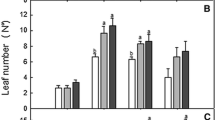Summary
In vitro rooted grape (Vitis vinifera L.) plantlets (4 or 8 wk from culturing microcuttings) were plantedex vitro in polythene sachets (24×12 cm) filled to one-third their height with planting mixture. The sachets were misted, closed, and incubated at ambient temperature (25–30°C) under 16 h photoperiod (40–50 μ E·m−2.·sec−1) for 1,2, or 3 wk before opening. Maximum establishment with no or minimum damage toin vitro formed leaves was obtained with 3 wk of closed sachet incubation in both age groups. Opening the sachet at 2 wk from planting resulted in marginal scorching of lower leaves and some reduction in establishment and vigor. Opening at 1 wk led to severe leaf scorching and significant reduction in establisment particularly in 4-wk-oldin vitro plantlets while growth was more affected in 8-wk-old ones. Relative humidity ofin vitro culture vessel was 68–75% while closed sachets had RH values of 45–77% depending on length of incubation and ambient RH. Diurnal variation in RH of sachet in relation to ambient RH was the major factor that facilitated acclimatization rather than the overall fall in RH during the period of closed incubation. Satisfactory acclimatization of plantlets to withstand the open sachet RH (50–55%) by 3 wk and the ambient RH (30–40%) by 4 wk was achieved. Monitoring water loss from detached leaves of plantlets showed a significant reduction between the date of planting and Week 3, and again between Weeks 3 and 4. Comparison of growthin vitro andex vitro suggested that shifting toex vitro earlier was more beneficial. This observation was confirmed by transferring 3-, 4-, and 5-wk-old plantlets fromin vitro rooting medium toex vitro and recording the growth at 8 wk fromin vitro culturing when 3 wkin vitro plus 5 wkex vitro combination showed maximum vigor. The leftover stumps after subculturing of 1–4-mo.-old stock cultures could also be effectively used forex vitro establishment.
Similar content being viewed by others
References
Bhojwani, S. S.; Dhawan, V. Acclimatization of tissue culture raised plants for transplantation to the field. In: Dhawan V., ed. Application of biotechnology in forestry and horticulture. New York: Plenum Press; 1988:249–256.
Blanke, M. M.; Belcher, A. R. Stomata of apple leaves culturedin vitro. Plant Cell Tissue Organ Cult. 19:85–89; 1989.
Brainerd, K. E.; Fuchigami, L. H. Acclimatization of aseptically cultured apple plants to low relative humidity. J. Am. Soc. Hortic. Sci. 106:515–518; 1981.
Brainerd, K. E.; Fuchigami, L. H.; Kwiatkowski, S., et al. Leaf anatomy and water stress of aseptically cultured Pixy plum grown under different environments. HortScience 16:173–175; 1981.
Compton, M. E.; Gray, D. J.; Elmstrom, G. W. A simple protocol for micropropagating diploid and tetraploid watermelon using shoot-tip explants. Plant Cell Tissue Organ Cult. 33:211–217; 1993.
Dami, I.; Hughes, H. Leaf anatomy and water, loss ofin vitro PEG-treated Valiant grape. Plant Cell Tissue Organ Cult. 42:179–184; 1995.
Dhawan, V.; Bhojwani, S. S. Hardeningin vitro and morpho-physiological changes in the leaves during acclimatization of micropropagated plants ofLeucaena leucocephala (Lam.) de Wit. Plant Sci. 53:65–72; 1987.
Driver, J. A.; Suttle, G. R. C. Nursery handling of propagules. In: Bonga, J. M.; Durzan, D. J., eds. Cell and tissue culture in forestry. Vol. 2. Specific principles and methods: growth and developments. Dordrecht, Netherlands: Martinus Nijhoff Publishers; 1987;320–335.
Faulks, L.; Mudge, K. W. Optimisation of environmental conditions of stage IV micropropagated grapes. HortScience 23:757; 1988.
Fournioux, J. C.; Bessis, R. Use of carbon dioxide enrichment to obtain adult morphology of grapevinein vitro. Plant Cell Tissue Organ Cult. 33:51–57; 1993.
Grenam, S., Micropropagation of grapevine (Vitis vinifera). In: Bajaj, Y. P. S., ed. Biotechnology in agriculture and forestry, 18. High-tech and micropropagation II. Berlin: Springer-Verlag; 1988:371–398.
Grout, B. W. W.; Aston, H. Modified leaf anatomy of cauliflower plantlets regenerated from meristem culture. Ann. Bot. 42:993–995; 1978.
Lewandowski, V. T. Rooting and acclimatization of micropropagated grapes. HortScience 26:586–589; 1991.
Marin, J. A.; Gella, R. Is desiccation the cause of the poor survival rate in the acclimatization of micropropagatedPrunus cerasus L.? Acta Hortic. 230:105–112; 1988.
Mohammed, G. H.; Vidaver, W. E. The influence of acclimatization treatment and plantlet morphology on early greenhouse-performance of tissue-cultured Douglas fir [Pseudostsuga menziesii (Mixb.) Franco]. Plant Cell Tissue Organ Cult. 21:111–117; 1990.
Mullins, M. G.; Nair, Y.; Sampet, P. Rejuvenation,in vitro: induction of juvenile characters, in an adult clone ofVitis vinifera L. Ann. Bot. 44:623–627; 1979.
Pierik, R. L. M. Handicaps for the large scale commercial application of micropropagation. Acta Hortic. 203:63–71; 1988.
Preece, J. E.; Sutter, E. G. Acclimatization of micropropagated plants to the glasshouse and field. In: Debergh, P. C.; Zimmerman, R. H., eds. Micropropagation technology and application. Dordrecht, Netherlands: Kluwer Academic Publishers; 1991:71–93.
Ravindra, M. B.; Thomas, P. Sachet technique—an efficient method for the acclimatization of micropropagated grapes. Curr. Sci. 68:546–548; 1985.
Read, P. E.; Fellman, C. D. Accelerating acclimatization ofin vitro propagated woody ornamentals. Acta Hortic. 166:15–20; 1985.
Rugini, E.In vitro propagation of some olive (Olea europea sativa L.) cultivars with different root-ability, and medium development using analytical data from developing shoots and embryos. Sci. Hortic. 24:123–134; 1984.
Sutter, E. G.; Langhans, R. W. Epicuticular wax formation on carnation plantlets regenerated from shoot tip culture. J. Am. Soc. Hortic. Sci. 104:493–496; 1979.
Sutter, E. G.; Novello, V.; Shackel, K. Physiological and anatomical aspects of water stress of cultured plants. Acta Hortic. 230:113–119; 1988.
Thomas, P. Increase in clonal propagation of Arka Neelamani grape (Vitis vinifera L.) through induction of axillaries inin vitro layering technique. Indian J. Agric. Sci. (In Press).
Werker, E.; Leshem, B. Structural changes during vitrification of carnation plantlet. Ann. Bot. 59:377–385; 1987.
Ziv, M.In vitro hardening and acclimatization of tissue culture plants. In: Withers, L. A.; Alderson, P. G. Plant tissue culture and its agricultural applications. London: Butterworths; 1986:187–196.
Ziv, M. Quality of micropropagated plants—vitrification. In Vitro Cell. Dev. Biol. 27P:64–69; 1991.
Author information
Authors and Affiliations
Rights and permissions
About this article
Cite this article
Thomas, P. Humid incubation period and plantlet age influence acclimatization and establishment of micropropagated grapes. In Vitro Cell.Dev.Biol.-Plant 34, 52–56 (1998). https://doi.org/10.1007/BF02823123
Received:
Accepted:
Issue Date:
DOI: https://doi.org/10.1007/BF02823123




